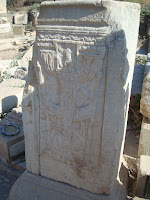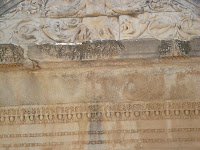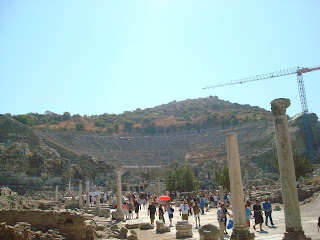The supposed last residence of the Virgin Mary, its location was lost for centuries until visions from a Catholic nun in Germany led to its rediscovery.


No photos are allowed inside. The house itself is quite small, with the main room having been converted into a shrine dedicated to the Virgin Mary. One thing of note is the red line differentiating between the original and the restored foundation.

 Sacred Water of the Virgin Mary
Sacred Water of the Virgin Mary A lot of people were bottling this water as it is said to have restorative properties. While normally I would try a sip, I refrained this time because I heard that the water is not exactly pleasant-tasting. Instead, I opted to splash some on my face. Why? I'm not sure, I just mimicked the person before me. Hopefully she knew what she was doing.
We entered the site through the eastern entrance, which is the easier (all downhill walking) of the two possible routes.
Ancient Ephesus was a coastal city and one of the most prosperous cities in the Mediterranean due to its prime geographical location for trade and commerce. It hosted the Temple of Artemis, one of the Wonders of the Ancient World. Unfortunately, nothing is left of the temple onsite save for a few broken columns. If you have some time, read about the Ephesian Artemis or "Lady of Ephesus", who is very different from the image we have come to associate with the goddess of the hunt.
The city was eventually abandoned when the coastal line receded and vessels no longer had access to the city. There was also the pesky problem of malaria, which killed a lot of its inhabitants.
The three sections, each distinguishable by a vaulted archway, are designated for hot, warm, and cold water.
Odeion
There's the marble VIP seating up front and the cheap seats in the back. Some things will never change.


Stoa
Covered public pathway with columns on either side.
It ran alongside the Upper/State Agora.

Basilica
 This was where
This was where Notice the bullheads decorating the Ionic columns. Aren't they amazing?
If there's one lesson our Greek tour guides were keen for us to learn, it was the identification of the different types of columns.
It's all in the capital! Ionic - scroll motif; Corinthian - acanthus leaves motif; and Doric - no motif.
Close-up of the bullhead motif.
Sign of the early Christianity movement in Ephesus.

 Prytaneion
PrytaneionWhere the sacred eternal fire was kept, symbolic as the "Heart of Ephesus."
Where misfit columns go to die... I kid, I kid.


 Look how well the road is paved; the relative evenness of the pavement stones.
Look how well the road is paved; the relative evenness of the pavement stones.The columns along the road are the ancient equivalent of lamp posts. It just goes to show you how much more advanced the Grecian/Roman cities were compared to their backwater cousins, like the Gauls or the Saxons.
 Domitian Square - Memmius
Monument
Domitian Square - Memmius
MonumentThis monument was erected by Gaius Memmius to commemorate his grandfather, Sulla the Dictator, and his father, also named Gaius.
More importantly, this monument served as a reminder of Sulla's victory over Mithridates, whom semi-advocated "independence" of the Asiatic cities (including Ephesus) from Roman control. (I'm pretty sure this is an over-simplification. Here's my source. I can't seem to find any other reference so take it with a grain of salt please.)
For those confused about the timeline: it's Sulla->Pompey->Caesar->Augustus
(Right) This is what the monument should look like once completely restored.
Domitian Square - Hospital and School of Medicine
Left: Unknown. Middle: Caduceus. Right: Hermes/Mercury, patron god



Domitian was the 11th Emperor of the Roman Empire. Unpopular with the Senate, he was assassinated at age 44 and his name posthumously besmirched.

 Fountain of Pollio
Fountain of Pollio
This public fountain was commissioned by, who else, a rich dude named Pollio and its basin once featured the story of Odysseus and the cyclops Polyphemus.
It must have been quite a beaut in its prime.
The fountain pedestal where the statues of Odysseus and Polyphemus would have likely stood. Look at all that detail.

Winged Victory of Domatian Square
 Curetes Street
Curetes Street One of the main streets of Ephesus, it starts at the Hercules Gate and ends at the Celsus Library.
And yes, there really was THAT many people there at 10 in the morning.

 Hercules Gate
Hercules Gate One of the gate pillars. This particular pillar shows Hercules with the Nemean Lion, one of the twelve labours.
Cats of Ephesus.
The Acropolis has its dogs. Ephesus, on the other hand, seems to be all about the felines.


Fountain of Trajan
The 13th Emperor of the Roman Empire. This fountain was considered one of the finest in the city.
Where the rich and powerful lived. Most of the terrace houses are still under restoration but isn't the mosaic floor of the portico amazing? Look at all the patterns and swirls.



Random photos along the Curetes Street.


A lone statue sitting amidst the ruins. A melancholy moment.

Temple of Hadrian
The 14th Emperor of the Roman Empire. Hadrian is perhaps best known for the wall in Britain that bears his name. Serendipitously, Hadrian and his wall was featured in a National Geography magazine article just before the start of the trip. He was an extremely hardworking emperor, having spent the first ten years of his reign surveying the empire. Keep his name in mind, because it'll definitely pop up again in later posts.


Above the door of the temple, Medusa watches from her perch.

Pay close attention to all the egg motifs throughout the temple, which symbolize fertility. The friezes on either side of the door illustrate the origins of Ephesus, including the role of the Amazons.





Scholastica Baths - Latrines
How about a little privacy? Those stalls are awfully close to one another.
How about a little privacy? Those stalls are awfully close to one another.

Hadrian's Gate
Originally three stories high, only the pillars framing the entrance remain.

 Library of Celsus
Library of CelsusThe library of Celsus held the third richest collection of scrolls in Ancient Mediterranean, falling only behind Alexandra and Pergamum.
The building reminds me of the Treasury in Petra from Indiana Jones and the Last Crusade.

 Mysterious footprints on the pedestal across from the library. I'm guessing this was where the statue of Athena stood?
Mysterious footprints on the pedestal across from the library. I'm guessing this was where the statue of Athena stood?
The female statues at the entrance of the library.
There are four in total: Wisdom, Knowledge, Intelligence, and Valour.


Columns, columns, and more columns...


Pieces waiting to be restored.

 The Great Theatre
The Great TheatreMAG-NI-FICENT.
It's hard to appreciate the size of the theatre in the photo until you see the person in the lower right corner. The theatre is about 4-5 stories high. And like the odeion, the VIP seats are made entirely of white marble.
The steps leading up to the theatre entrance are quite steep; a woman from our group fell and broke her leg climbing down. I suppose the ancient Ephesians didn't think too much about safety or accessibility when designing the theatre.
Arcadian Street
This street links the habour to the Great Theatre and was one of the few fully-lit streets at the time. We arrived just in time to see the performances. Two gladiators dueled and then a procession lead by Cleopatra and Marc Anthony. It was pretty cheesy but in a highly enjoyable kind of way.
The Great Theatre from a distance. Bye for now!












Oh noes! Was your tour mate ok? Did she have to fly home?
ReplyDeleteIt's hard to believe you saw all this in a day (morning?) So much history--and tourists, lol--in one place. After about 10 minutes, I think I'd get so tired, I would stop trying to imagine what the things actually looked like in their hey days.
Do you know if the four woman statues at Celsus are the originals? Either way, they're beautiful. I wish we could have more of that kind of thing back home. I'd SO rather have the statues than the cafe at the Reference Library.
So many people! 0.o How did you deal with it?
An ambulance came for her and brought her to a local hospital. I'm not sure what happened afterwards. Most likely scenario is that she probably had to fly home.
DeleteAfter awhile, the ruins do kind of blur together. Sensory overload - there are only so many Roman statues one can absorb in a 12-hour window.
The virtue statues are copies, alas. The originals are in the Ephesus museum in Vienna (!!!) I know, I was just as surprised. I suppose this calls for a trip to Vienna!
The massive crowd was constantly moving so there wasn't any bottlenecks. Just by going with the flow, it wasn't too bad. Or maybe I'm just used to Taipei's MRT rush hour crowd...